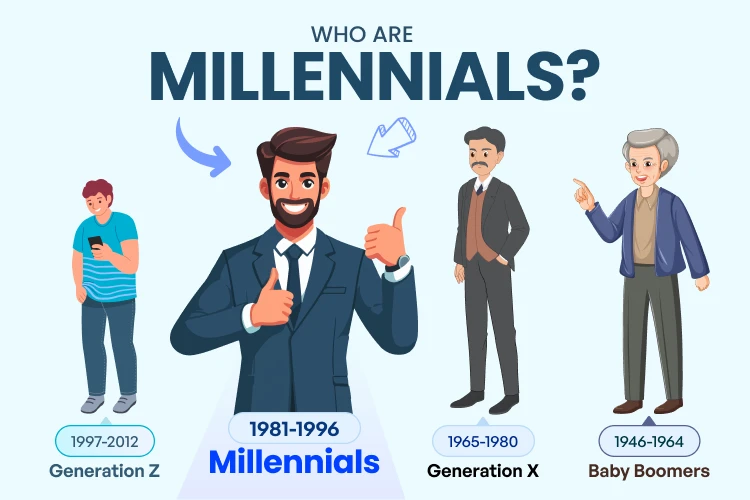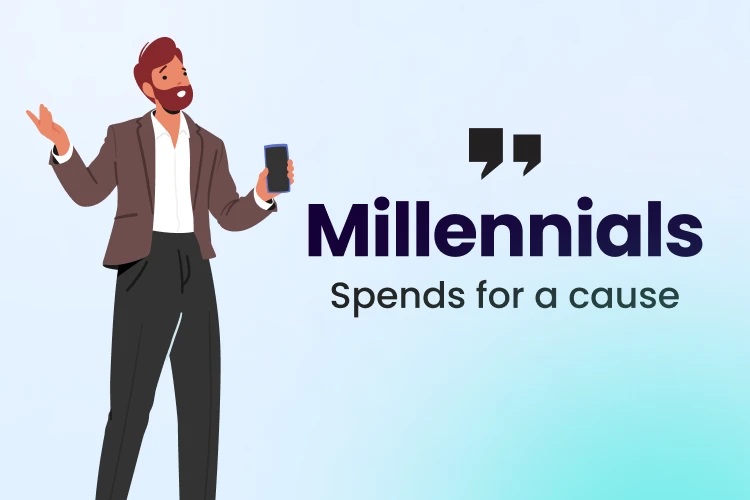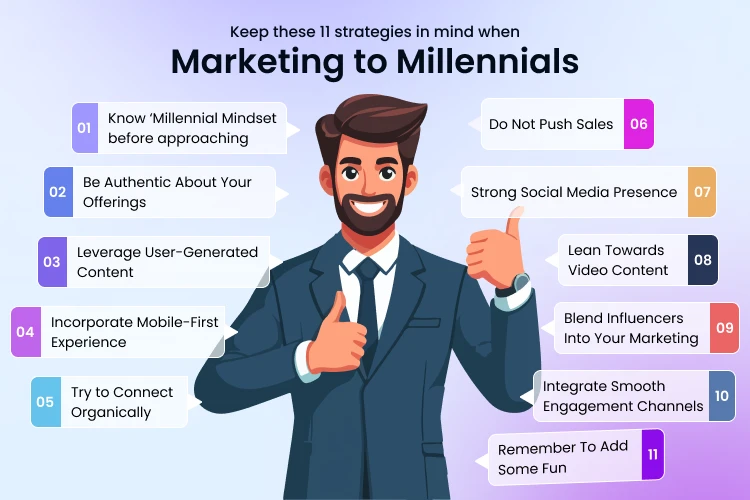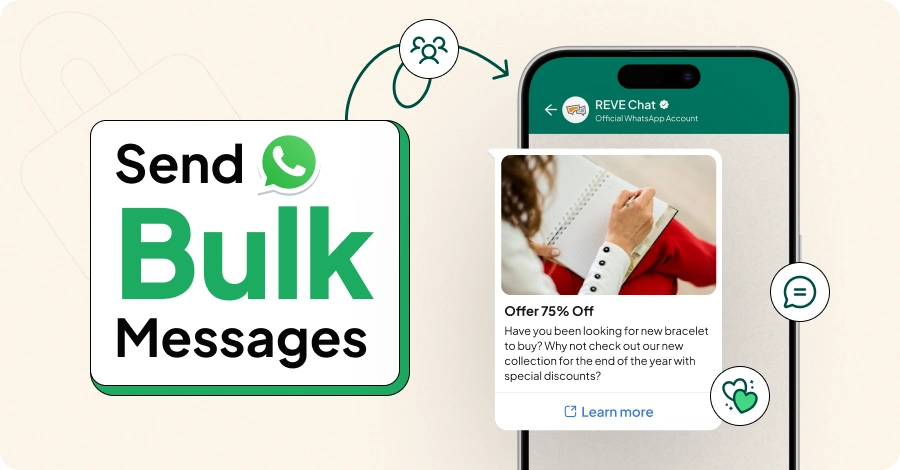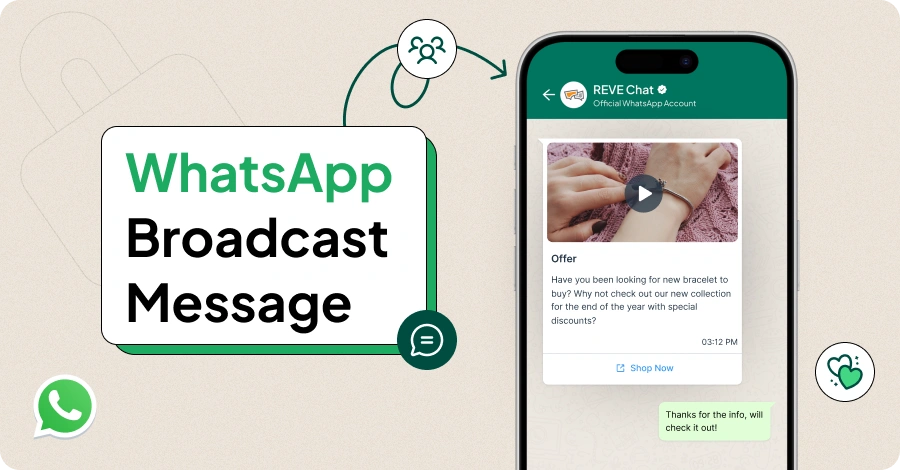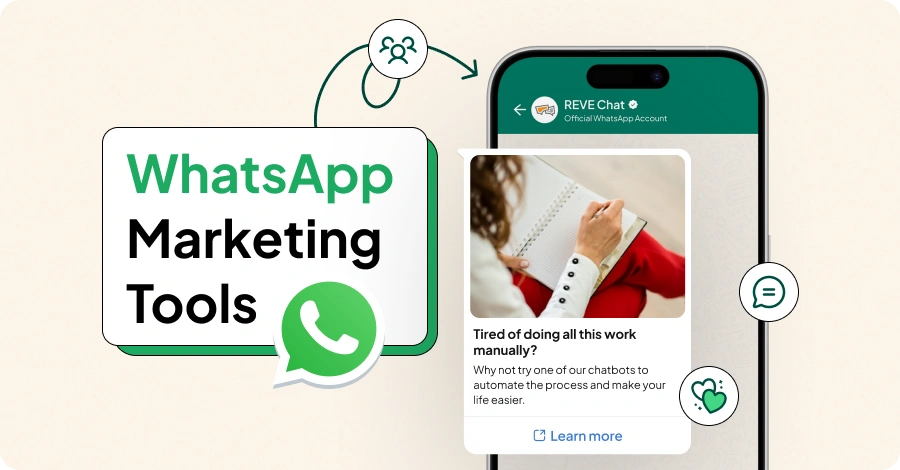Marketing to Millennials: 11 Traits and Key Strategies
- December 21, 2023
- 13 mins read
- Listen

Table of Content
It is surprising how marketing behavior evolves from generation to generation; every generation is born with unique characteristics. Marketing to millennials’ strategies differ from other generations based on their characteristics.
Globally, around 25% of the population falls into the category of millennials. Millennials, known as a generation of compassionate and empowered consumers, they don’t just buy; they make purchases to create an impact. Millennial marketing requires understanding, strategies, and an approach that goes beyond traditional marketing patterns.
You will be able to connect more once you know who millennials are, their unique purchase behavior, and how to approach them. One thing you might be wondering is why their importance is noteworthy. What makes a generation so decisive that it reshapes the entire landscape of brand and marketing strategies?
This blog intends to provide you with a concise overview of Millennial Marketing.
Who are Millennials?
Millennials are the generation born between 1981 and 1996, also known as Generation Y. They’ve been shaped by significant historical events, technological advancements, and cultural shifts, making them a fascinating group to understand.
The oldest millennials were approaching adulthood around the year 2000, coinciding with the turn of the millennium.
Thus, they were named after the historical significance that marked a distinct shift in the social and technological landscape.
As of the current year (2024), the eldest millennial would be 41 years old, while the youngest would be 27. The last millennial has reached the age of generation maturity.
They are booming in number making them the largest consumer prospect in the recent economy.
The generation before millennials are called Baby Boomers ( 1946-1964) and Generation X (1965-1980). Generation Z (1997-2012) is the generation after millennials.
Why Millenials are Important to Marketers?
Globally Millennials make up an estimated 24% of the world’s population, amounting to roughly 1.9 billion people. If you are looking to plan a massive market exposure, a large portion of your targeted group will probably be the millennials.
Millennials are the generation that faced two massive pandemics – The Great Recession ( 2008-2009) and COVID-19 (2020). They are also the people who witnessed the explosive rise of technology and social media. The overall shift has made the millennial consumer behavior different from the rest of the generation.
Conventional one-size-fits-all marketing no longer serves this dominating generation of the tech era. Let’s look at some current data that shows why millennials are important in the market.
Uprising trends
- Studies in 2023 showed that in the US market itself, millennials held a collective buying power of around $2.5 trillion. This is a substantial increase compared to the 2022 figures.
- Millennials account for approximately 27% of all retail spending in the US.
Buying power
- In the US alone, Millennials wield an estimated $1.5 trillion in annual buying power. This number is expected to reach $2.6 trillion by 2025. Their current average income may not be as high as older generations. However, millennials are projected to experience significant income growth in the coming years.
- Millennials make up 38% of all home buyers in 2024 according to the National Association of Realtors’ 2024. This is a significant jump from 28% in 2023, showcasing their growing presence in the market.
Market Transformation
- Millennials have fundamentally reshaped the marketing landscape. They grew up with a smartphone in their pocket and prefer online shopping to brick-and-mortar. This transformation has given the floor to marketers to expand their fields more. You can set new strategies for this generation and experience from the new marketing campaigns.
Types of Marketing that Attract Millennials Most
The nature of marketing has seen variations across generations. Reflecting on the Silent Generation (Born before 1945), this group’s upbringing was shaped by marketing channels such as radio and print media. Baby boomers progressed to engaging with television commercials. Here, we have several types of marketing that are particularly favored by millennials.
- Influence Marketing
- Social Media Marketing
- Mobile-first Marketing
- Content Marketing
- Impactful Marketing
- Influencer Marketing
Influence Marketing
Influence marketing is so far the most significant marketing strategy for millennials. They are more likely to connect with people first before trusting any brand. Therefore, it significantly influences this era when beloved figures discuss a specific brand. It builds trust and credibility.
Social Media Marketing
Social Media is another important channel of marketing for the millennials. They saw the rise of social media platforms like Instagram, Twitter, and Snapchat. They have got so used to these platforms that a big percentage of their buying channel consists of social media platforms.
Mobile-first Marketing
Millennials are glued to their phones. Ensure your website is mobile-friendly and consider SMS marketing or social media ads specifically designed for mobile viewing.
Content Marketing
Skip the sales pitches. Create informative blog posts, articles, or videos that solve their problems, teach them something new, or entertain them in a way that aligns with your brand. Millennials appreciate valuable content.
Impactful Marketing
Millennials care about social responsibility. Partner with causes that support or integrate charitable elements into your loyalty programs. Show them your brand makes a positive difference.
Top Millennial Unique Purchase Behaviors
As previously mentioned, the purchasing behavior of millennials sets them apart from other generations. We have outlined five behavioral traits to enhance your understanding of them.
- Ethically and Socially Concerned Consumers
- Tech Savvy, E-commerce Preference
- Believing in Value-Driven Purchases
- Social Media-Driven and Influential Marketing
- Prefer Instant Gratification Provider
1. Ethically and Socially Concerned Customers
Millennials are ethically and socially concerned consumers. They prefer responsible brands and businesses. Brands like Patagonia, Cotopaxi, and Back Market are socially concerned. Their buyers are largely millennials.
They just don’t spend. They spend for a cause. Sustainability is one of the key considerations in millennial purchase decisions.
If your business hasn’t taken corporate social responsibility seriously yet, it may struggle to connect with this generation.
Things to Offer
- Be transparent about your product’s supply chain
- Implement an ethical ecosystem throughout the business
- Support social causes as the core of your values.
- Leverage storytelling marketing for a personalized experience
2. Tech Savvy, E-commerce Preference
Millennials shop smart, not hard.
Did you notice the surge in the number of e-commerce enterprises as millennials entered adulthood?
This generation loves technology, and that extends to their shopping habits. Millennials are often glued to their smartphones, researching products online before making a purchase. They’re also not shy about contacting sellers post-purchase.
A seamless online purchase option will engage them more towards your business. Don’t ever forget their love for smart features.
Millennials will love your physical shops if you have integrated smart checkout systems, interactive displays, smart fitting rooms, customer recognition technology, and other smart shopping experiences.
Things to Offer
- Offer data-driven product recommendations
- Integrate omnichannel shopping experience
- Embrace innovation and technological advancements
3. Believing in Value-Driven Purchases
A value-driven purchase is when a consumer’s decision to buy something is primarily influenced by factors beyond just the product’s price and functionality.
These factors can be personal, ethical, societal, or environmental, and often align with the consumer’s values.
Epsilon-Conversant’s “2023 Generation Z & Millennial Shopping Behavior Report”: Revealed that 87% of Millennials say they prefer to buy from brands that support the same causes they do.
As per millennial purchase behavior, they look for value in every purchase. For example, if you have a 6-month subscription offering a discount, a millennial consumer would prefer that. Additionally, they will find your business more valuable if it serves any social causes.
Things to Offer
- Tell stories that resonate with your target audience
- Focus on quality and longevity over fast fashion or disposable trends
- Offer impactful experiences with every purchase
4. Social Media-driven and Influential Marketing
Millennials are savvy social media users. They understand that every click, share, and comment plays a role in building their online presence and personal brand.
Let’s look at some commonly used social media and their founding years,
- LinkedIn – 2003
- Facebook – 2004
- YouTube- 2005
- Twitter- 2006
- Pinterest – 2010
- Snapchat- 2011
Millennials were the early adopters of these platforms. Social media platforms changed how they connect and communicate in their regular lives.
Influential marketing too has a great impact on millennials.
Reports from different sources show that around 80% of millennials follow influencers on social media. Sixty-five percent of them consider influencers’ recommendations before making buying decisions.
Things to Offer
- Be available on social media and regularly post updates
- Respond to both positive and negative reviews promptly
- Collaborate with influencers to create engaging content
5. Prefer Instant Gratification Provider
Instant gratification providers are businesses and services. They cater to our desire for immediate satisfaction.
For example, Foodpanda, if you are craving a meal, this app connects you with restaurants and delivers food straight.
Using Uber, you can book a car instantly for your rides.
Netflix, sourcing your favorite movies, TV shows, music, and podcasts for instant entertainment needs.
Millennials love instant gratification providers. Growing up in an environment filled with modern amenities, they witnessed a streamlined buyer journey.
The ability to get items when and where they want added convenience to their daily lives. This also transformed how they view consumption, preferring experiences tied to immediate satisfaction.
Things to Offer
- Offer hyper-convenient service solutions, such as same-day delivery.
- Propose immediate product experiences, such as complimentary trials.
- Use countdown timers, flash sales, or limited-quantity deals to create a sense of urgency.
How to Market to The Millenials?
Understanding consumers’ mindset makes marketing to millennials simpler. It doesn’t have to be rocket science. Here are your 11 strategies for successful marketing campaigns.
- Know ‘Millennial Mindset’
- Be Authentic About Your Offerings
- Leverage User-Generated Content
- Incorporate Mobile-First Experience
- Try to Connect Organically
- Do Not Push Sales
- Strong Social Media Presence
- Lean Towards Video Content
- Blend Influencers Into Your Marketing
- Integrate Smooth Engagement Channels
- Remember To Add Some Fun
1. Know ‘Millennial Mindset’
Your marketing plan should align with the millennial mindset if you target them. Know how they think, what they prefer, and how they want to connect. Incorporate personalized experience at every customer touchpoint.
2. Be Authentic About Your Offerings
Millennials are notorious for their skepticism towards traditional marketing. Stop throwing jargon and buzzwords. They prefer authenticity and transparency in branding.
Be upfront about pricing, promises, and any product limitations. Craft your content in a manner that resonates with millennials on a personal level, leaving them with a ‘made for you’ feeling.
3. Leverage User-Generated Content
User-generated content( UGC) is the original content produced for a brand by the authentic user. 85% of millennials say that UGS inspires them more than professional photos while choosing to buy a product.
As they prefer authenticity, UGC makes them trust your product. You should get reviews from your regular users and showcase them on your digital platforms.
4. Incorporate Mobile-First Experience
Mobile-responsive experience is important to millennials. It eliminates unnecessary steps of switching devices. It incorporates seamless transition between tasks and fits activities into busy schedules.
They acknowledge the value of time. Your marketing strategies should include mobile experiences.
5. Try to Connect Organically
If your business depends on paid marketing only, it’s time to level up. Millennials prefer organic connections. Share blog posts, videos, or tutorials that offer real value and insights related to your brand or industry.
Avoid artificial marketing copies and empty promises. The primary purpose of your marketing should be educating the users.
6. Do Not Push Sales
Direct sales pitches are a big no for millennial consumers. If you ask them to buy your product, they will move further from your brand. Outbound push sales lack a personalized approach.
The goal of push sales is to make the customer take immediate action. Creating this type of urgency works negatively for millennials.
So, do not push sales; rather, push value-driven information on how your product makes an impact.
7. Strong Social Media Presence
In the United States, millennials spend an average of 2 hours and 55 minutes on social media each day. This is almost double the time spent by Baby Boomers (1 hour and 22 minutes) and Gen Z (2 hours and 42 minutes). – Pew Research Center, 2023
Social media is one of the best marketing channels for millennials. Any business with a millennial target market should list SMM presence as a priority. Social media provides a platform for two-way communication.
Millennials appreciate brands that engage with their audience. They like it when brands respond to comments and actively participate in conversations. Additionally, make your social content available for share
8. Lean Towards Video Content
Video content removes monotony and shows interactivity in brand voices. If you can leverage video content as a social marketing strategy, millennials will love your message.
They’re active on all the major video platforms, including YouTube: Instagram, TikTok, and Twitch. It will improve the overall look and feel of the experience of a product.
9. Blend Influencers Into Your Marketing
Millennials trust peer recommendations from influencers.
They love authenticity and user-generated content. This makes the perfect blend for influencers to be an asset to millennial marketing. Let influencers be your product reviewers.
It will remove the buying hesitation and promote brand value.
10. Integrate Smooth Engagement Channels
User experience has high value for Generation Y, aka millennials. Your customer touchpoints should be easy to reach. They will not entertain mediocre customer service.
If you delay responding to a millennial, you will see them leave in a moment. You may incorporate a live chat and chatbot into your customer services so that they can act fast on customer demand.
11. Remember to Add Some Fun
Fun content is more likely to stick in the minds of millennials. This generation is known for having shorter attention spans.
Adding some fun, like quizzes and memes, can lead to stronger brand recall. People remember the brand better when they are making purchasing decisions.
Building Trust with Millenial Marketing Strategies Using REVE Chat
Credibility is the first stage to build trust with millennials. They place importance on a brand’s prompt connection with its customers. Thus, you can strengthen your business using REVE Chat, a renowned customer engagement platform in empowering marketing strategies directed toward millennials.
Millennials appreciate instant communication. Utilize REVE Chat’s chatbot feature to provide real-time assistance and support. Also, integrates across multiple platforms. This includes website chat, social media, and messaging apps. Offer omnichannel customer support.
Additionally, you can offer personalized customer interactions with live chat. Engage with visitors on your website. Offer assistance before they even ask for it. Ensure consistency in messaging and support across these channels.
End Note
Reaching millennials through marketing can take longer than other groups. However, once done correctly, it brings sustainable ROI. Marketing to millennials is a thoughtful process. They are drawn to brands that align with their values. Demonstrating a clear purpose beyond profit and contributing to social causes can create a stronger connection with this demographic.

